Inside The New York Botanical Garden
birdwatching
Posted in Adult Education on September 24 2012, by Matt Newman
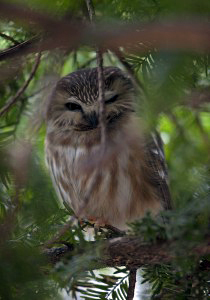 The New York Botanical Garden is, first and foremost, a world-renowned collection of flora. But you’d be hard-pressed to spend more than a few minutes walking under the boughs without recognizing the sing-song notes of our most gregarious residents. The birds of the Garden represent some of the most varied fauna in New York City, and not only are we a haven for passersby making the trip to cozier climates, but we’re further home to a menagerie of year-round species in all shapes and sizes.
The New York Botanical Garden is, first and foremost, a world-renowned collection of flora. But you’d be hard-pressed to spend more than a few minutes walking under the boughs without recognizing the sing-song notes of our most gregarious residents. The birds of the Garden represent some of the most varied fauna in New York City, and not only are we a haven for passersby making the trip to cozier climates, but we’re further home to a menagerie of year-round species in all shapes and sizes.
It so happens that we get the best of both worlds in the fall. Migrating species gather up for the flight south while the locals buckle down for the coming winter, and Debbie Becker, binoculars in hand, is always there to see it; join her for our in-depth NYBG birdwatching course beginning in October and you’re sure to walk away with a new skill.
While the herons and egrets are soon to take flight for the season, and the hummingbirds already have their eyes on the clock, few realize how abundant the wildlife is here in the autumn. Thankfully, Becker has the roll call down pat. She’s been leading Saturday Bird Walks at the NYBG for over 25 years, making her one of the area’s foremost experts on NYC’s winged things. And while newcomers are always welcome to glean what they can from her weekend walks, motivated beginners won’t want to pass up Becker’s primer on birdwatching fundamentals.
Read More
Posted in Around the Garden, People, Photography, Wildlife on May 31 2012, by Matt Newman
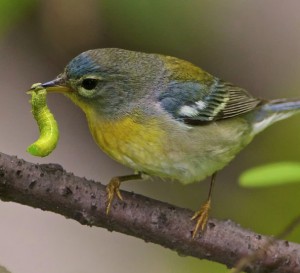 What’s a forest without the chatter of songbirds, or a pond without a curmudgeonly duck or two? Tom Andres, an Honorary Research Associate at the NYBG, won’t even consider the possibility. He’s too busy snapping pictures of our avian population.
What’s a forest without the chatter of songbirds, or a pond without a curmudgeonly duck or two? Tom Andres, an Honorary Research Associate at the NYBG, won’t even consider the possibility. He’s too busy snapping pictures of our avian population.
It’s no great secret that The New York Botanical Garden is a northern birder’s paradise, home to owls, hawks, herons, and woodpeckers. Debbie Becker’s Saturday Bird Walks remain a staple at the Garden, now over 25 years since she began guiding groups of amateur and veteran birdwatchers alike through our 250-acre landscape. Even so, populations change with the seasons–migrants flood the Garden with song and color one week, only to disappear the next.
Tom doesn’t let the fickle nature of the birder’s obsession hamper his photography, much less his fascination. “The Garden plays an important role for feathered visitors,” he writes, “especially as a refueling point during migration season.” The Bronx River Corridor–winding through the Garden–is a major draw for neotropical birds migrating toward northern breeding grounds, or heading south for warmer climates. This explains the sudden influx of loud and bright warblers arriving early in spring, making a much-needed pit stop before they move on.
Read More
Posted in Around the Garden on June 8 2011, by Ann Rafalko
Have you been looking for a good reason to visit the Garden this June? Well, if you need some motivation to visit New York City’s greatest garden, consider us your motivators: This weekend is going to be spectacular! We have flowers, food, dancing, music, poetry, and so much more in store!
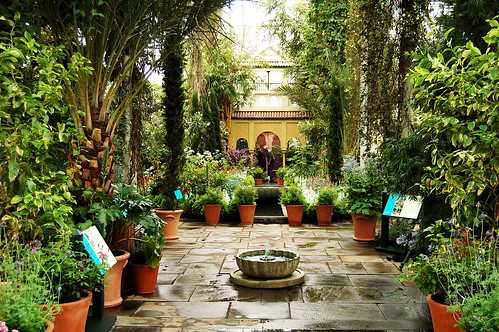 Start in the historic Enid A. Haupt Conservatory, where the best-smelling exhibition in New York City–complete with flowing fountains and elegant arches–is housed in the Victorian elegance of this landmark building. Be sure to visit the beautiful reflecting pool and its resident koi in the Conservatory Courtyard. A Garden Tour Guide-led guided tour of the exhibition is available Saturday and Sunday at 2:30 p.m. Meet at the entrance to the Conservatory.
Start in the historic Enid A. Haupt Conservatory, where the best-smelling exhibition in New York City–complete with flowing fountains and elegant arches–is housed in the Victorian elegance of this landmark building. Be sure to visit the beautiful reflecting pool and its resident koi in the Conservatory Courtyard. A Garden Tour Guide-led guided tour of the exhibition is available Saturday and Sunday at 2:30 p.m. Meet at the entrance to the Conservatory.
Saturday, June 11, 2011
My Lorca Poetry Series – 4 p.m. in the Perennial Garden
Hear American poets read their favorite Federico García Lorca poems and discuss the poet’s influence on their own work as part of Spanish Paradise: Gardens of the Alhambra. Poets: Christopher Maurer, Jaime Manrique, and Mark Statman. Co-presented with the Poetry Society of America.
Flamenco Among the Flowers – 1, 2, and 3 p.m. in the Arthur and Janet Ross Lecture Hall
The Garden comes alive with the sounds, rhythms, and movements of flamenco. Flamenco: Inside/Out introduces this traditional Spanish art form using live music and performers from various ethnic, cultural, and artistic backgrounds.
Sunday, June 12, 2011
The Food and Culture of the Alhambra – 4 p.m. in the Perennial Garden
Join chef and culinary historian Maricel Presilla for a fascinating, and delicious, exploration of the cuisine and culture of the al-Andalús region of Spain, home to the Alhambra. Presilla, who holds a doctorate in medieval Spanish history from New York University, has received formal training in cultural anthropology, and is a Beard Award-nominated chef, will be talking about several aspects of Islamic agriculture and cooking in al-Andalús. She will focus on vegetables, grains, nuts, olive oil, fermented condiments, aromatic spices (and spice mixes) and flowers, particularly scented roses. Her cooking demonstration may include: a spice mix or sauce; an eggplant dish called alboronía or another thirteenth-century dish with eggplant served with aromatic lamb meatballs (albóndigas), and a rose-scented dessert that shows the connection between al-Andalús and the New World. She will also be talking about the Islamic roots of the popular sweet and sour Spanish dish known as escabeche.
Tour of Library Exhibition Historical Views: Tourists at the Alhambra – Meet at 1 p.m. in the Orchid Rotunda at the entrance level to the Library Building
Join a Garden Tour Guide for a tour of Historical Views: Tourists at the Alhambra.
Flamenco Among the Flowers – 1, 2, and 3 p.m. in the Arthur and Janet Ross Lecture Hall
The Garden comes alive with the sounds, rhythms, and movements of flamenco. Flamenco: Inside/Out introduces this traditional Spanish art form using live music and performers from various ethnic, cultural, and artistic backgrounds.
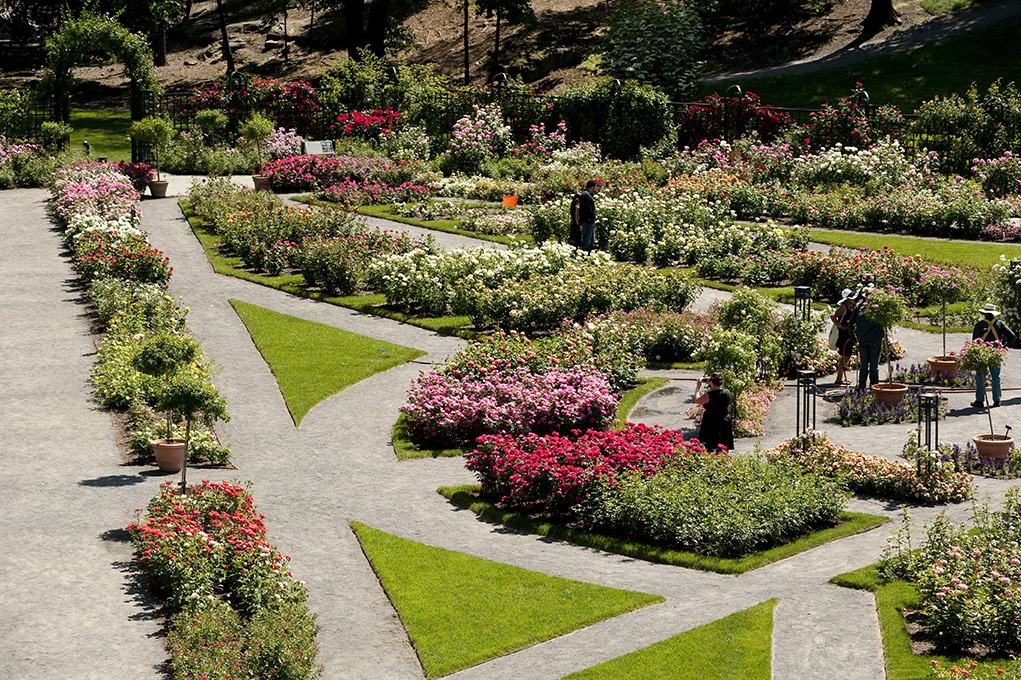 The award-winning Peggy Rockefeller Rose Garden one of the world’s most sustainable and beautiful showcases for America’s flower, and it is in full bloom right now! Set aside ample time so that you have as many minutes as you need to stop and smell the roses. In the Peggy Rockefeller Rose Garden, the roses smell as good as they look.
The award-winning Peggy Rockefeller Rose Garden one of the world’s most sustainable and beautiful showcases for America’s flower, and it is in full bloom right now! Set aside ample time so that you have as many minutes as you need to stop and smell the roses. In the Peggy Rockefeller Rose Garden, the roses smell as good as they look.
Sunday, June 12, 2011
Book Signing with Peter Kukielski – 11 a.m.-1 p.m. at Shop in the Garden
Meet the man behind the sustainable rose revolution. Curator of the Peggy Rockefeller Rose Garden, Peter Kukielski, will be signing copies of The Sustainable Rose Garden at Shop in the Garden, a volume of essays he co-edited with Pat Shanley and Gene Waering.
Saturday, June 11 and Sunday, June 12, 2011
Rose Garden Tour – 12:30 p.m. in the Peggy Rockefeller Rose Garden
Immerse yourself in the fragrance, color, and beauty of the award-winning Peggy Rockefeller Rose Garden on a tour with a Garden Tour Guide offered each day in June; and with an ASL interpreter on June 18. Learn the differences between heritage and modern roses, and between floribundas and hybrid teas, as well as facts about rose history, cultivation, and folklore.
Q&A Sessions with Rose Experts – 1-4 p.m. at the Peggy Rockefeller Rose Garden pergola
Our rose experts will answer your questions on caring for roses, cultivars to try in your garden, the history of the Peggy Rockefeller Rose Garden, and more.
Home Gardening Demonstration: Life is Rosy – 1:30 p.m. in the Peggy Rockefeller Rose Garden
Tour the sumptuous, award-winning Peggy Rockefeller Rose Garden. Learn standard rose-care practices, from fertilizing to pruning.
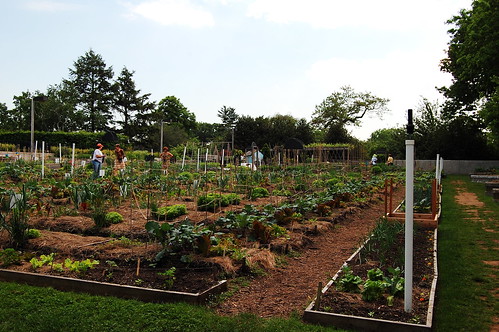 The Garden is a great place to get outside and enjoy nature: families can explore the natural world in the Everett Children’s Adventure Garden and at the Ruth Rea Howell Family Garden; gardeners can gather inspiration for their own gardens throughout the Garden’s 250-acres, and learn about plant varietals in the Home Gardening Center; and naturalists can spot a variety of migratory and year-round birds throughout the grounds.
The Garden is a great place to get outside and enjoy nature: families can explore the natural world in the Everett Children’s Adventure Garden and at the Ruth Rea Howell Family Garden; gardeners can gather inspiration for their own gardens throughout the Garden’s 250-acres, and learn about plant varietals in the Home Gardening Center; and naturalists can spot a variety of migratory and year-round birds throughout the grounds.
Saturday, June 11, 2011
Bird Walk – meet at 11 a.m. at the Reflecting Pool in front of the Leon Levy Visitor Center
Bring your binoculars and walk the Garden grounds with our bird expert, Debbie Becker. On your walk you will look for the species that live here year-round as well as those just migrating through: owls, hawks, songbirds, and more. Learn about the bird-friendly plants and habitats that provide food, shelter, and nesting sites. Learn more about birding at the Garden in this short video.
Saturday, June 11 and Sunday June 12, 2011
Global Gardens Spring Harvest Celebration – 1:30-5:30 p.m. in the Ruth Rea Howell Family Garden
Travel globally while eating locally! Celebrate the end of spring with our Global Gardeners. Travel to China, Korea, Ireland, Italy, and the Caribbean by visiting each Global Garden plot and earn stamps in your Garden Passport as you learn and explore.
Posted in Programs and Events, Wildlife on May 29 2009, by Plant Talk
Spring Brings Special Sightings
 |
Debbie Becker leads a free bird walk at the Garden every Saturday from 11 a.m. to 12:30 p.m., beginning at the Reflecting Pool in the Leon Levy Visitor Center. The last one for the season will be June 27.
|
Three fuzzy heads can be seen bobbing up and down in the red-tailed hawk nest. Just like Central Park’s Pale Male and Lola, our red-tails have made a neat little “cliffside” home at the top of a structure—in this case the Library building. It is interesting to watch mom and pop fly in with food to feed the babies. The hawks’ diet consists mainly of small mammals (such as squirrels and chipmunks) and birds, keeping the balance of nature in check. The female red-tail seems to find mockingbirds a special treat and has resorted to robbing mockingbird nests. Recently, we saw the red-tail perched atop the Watson Building with a baby mockingbird in her talons and mother mocker desperately trying to get mother hawk to free her prey. The mocker aggressively attacked the hawk, but in the end the hawk had a meal for her babies and the mocker went home to an empty nest. It is the circle of life.
While searching for warblers in the Forest we were treated to a very rare sight at this time of year: Our well-hidden female great horned owl flew from her perch followed by her fledgling. We were able to follow the mature owl to a new perch but lost the young owl in the leaves. As we watched the mom settle in, she kept looking around for her baby. Suddenly she looked forward and began to hoot. Then she turned her head right and hooted and then left and hooted. I guess she heard the young owl reply, because she closed her eyes and seemingly went to sleep.
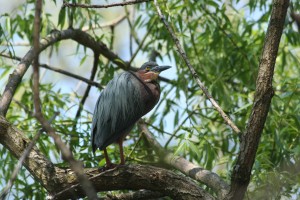 As the warbler numbers begin to dwindle, the birds having moved on to northern climes, we are grateful for another wonderful migration. Most of us were treated to the sightings of warblers such as black-throated blue, black-throated green, northern parula, Tennessee, chestnut-sided, bay-breasted, American redstart, common yellowthroat, yellow, prothonotary, and ovenbird. We also had warbling, red-eyed, and blue-headed vireos and a long list of other spectacular birds: Baltimore oriole, scarlet tanager, rose-breasted grosbeak, wood thrush, veery, hermit thrush, gray catbird, brown creeper, house wren, rough-winged swallow, bank swallow, tree swallow, chimney swift, eastern kingbird, great blue heron, great egret, night-heron, green heron (in full breeding plumage, see above photo, courtesy Debbie Becker), cormorant, wood duck (adults with 11 babies), mallard (adults with 12 babies) indigo bunting, cedar waxwing, savannah sparrow, ruby-throated hummingbird, eastern towhee, and northern flicker.
As the warbler numbers begin to dwindle, the birds having moved on to northern climes, we are grateful for another wonderful migration. Most of us were treated to the sightings of warblers such as black-throated blue, black-throated green, northern parula, Tennessee, chestnut-sided, bay-breasted, American redstart, common yellowthroat, yellow, prothonotary, and ovenbird. We also had warbling, red-eyed, and blue-headed vireos and a long list of other spectacular birds: Baltimore oriole, scarlet tanager, rose-breasted grosbeak, wood thrush, veery, hermit thrush, gray catbird, brown creeper, house wren, rough-winged swallow, bank swallow, tree swallow, chimney swift, eastern kingbird, great blue heron, great egret, night-heron, green heron (in full breeding plumage, see above photo, courtesy Debbie Becker), cormorant, wood duck (adults with 11 babies), mallard (adults with 12 babies) indigo bunting, cedar waxwing, savannah sparrow, ruby-throated hummingbird, eastern towhee, and northern flicker.
Read More
Posted in Programs and Events, Wildlife on April 24 2009, by Plant Talk
Expect Warblers, Wood Ducks, More on this Weekend’s Bird Walks
 |
Debbie Becker leads a free bird walk at the Garden every Saturday from 11 a.m. to 12:30 p.m., beginning at the Reflecting Pool in the Leon Levy Visitor Center. This weekend, she’ll also lead a walk on Sunday, same time and place.
|
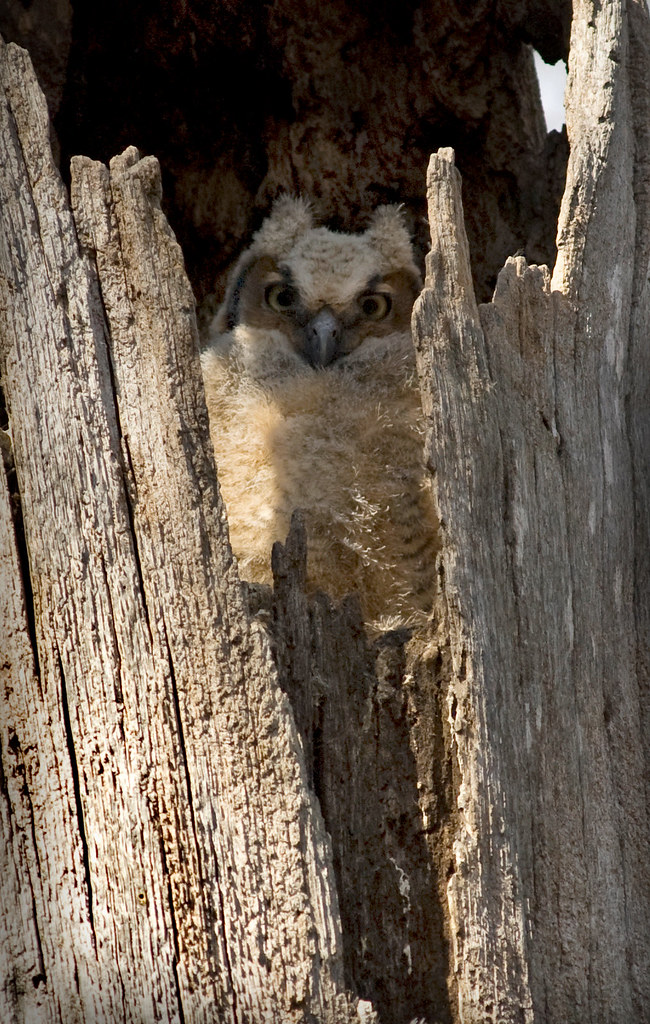 Spring has sprung at NYBG!
Spring has sprung at NYBG!
The phoebe, spring’s harbinger, has been singing its wonderful namesake song throughout the forest. Wood thrush are chiming in along with white-throated sparrows, tufted titmice, and cardinals.
While some birds are singing to lure a mate, some of our larger predators are already proud parents. Our red-tailed hawks appear to have one baby in their nest, built on a cliff-like shelf of the Library building. Mom and pop can be seen flying in and out with tasty morsels to feed the nestling.
Our baby great horned owls fledged their nest in the Forest. Last Saturday, only one baby was left in the nest (see photo) with Dad watching over him like a hawk (or should I say owl). The other owlet was somewhere in the Forest with Mom, learning how to fly and watching her hunt. Earlier this week, the second baby also fledged and now birders are treated to a spectacular show of watching them flap their brand-new wings and hop from branch to branch.
Warblers are beginning to invade the Garden. Some birders I know save all their vacation days for the last week of April and first week of May to look for these gems. Warblers are small, colorful birds that migrate from as far south as South America to the far northern reaches of the United States and southern Canada. Escaping predators and feeding on newly hatched insects, they travel up the eastern coast in the tens of thousands every April and May to their breeding grounds. This is the only chance each year to see these long-distance travelers in their brilliant breeding plumage, and birding NYBG gives you every opportunity to observe them. Last Saturday’s walk yielded a palm warbler, pine warbler, and yellow-rumped warbler.
To learn more about the birds at the Botanical Garden…
Read More
Posted in Programs and Events, Wildlife on March 27 2009, by Plant Talk
Saying Hello to New Arrivals and Goodbye to a Friend
 |
Debbie Becker leads a free bird walk at the Garden every Saturday from 11 a.m. to 12:30 p.m., beginning at the Reflecting Pool in the Leon Levy Visitor Center.
|
 Spring has sprung at NYBG. The phoebe, spring’s harbinger, has arrived. A beautiful phoebe was spotted down by Twin Lakes bobbing its tail and calling. Ruby-crowned kinglets, brown creepers, and a juvenile eastern kingbird were also spotted on last Saturday’s walk.
Spring has sprung at NYBG. The phoebe, spring’s harbinger, has arrived. A beautiful phoebe was spotted down by Twin Lakes bobbing its tail and calling. Ruby-crowned kinglets, brown creepers, and a juvenile eastern kingbird were also spotted on last Saturday’s walk.
Perhaps the best indication of spring is seeing the mating rituals that some of the birds perform. The male mockingbird does a dance on the lawn by extending his wings and flashing his white stripes. The female, who looks exactly like the male, is an onlooker who watches from afar. She may judge him on his display or wait further to hear the kaleidoscope of songs that emanate from his vocal cords when he is high atop a tree. Many mockingbirds mock sounds they hear in their vicinity. NYBG mockers often imitate the other birds at NYBG along with alarm systems from cars and sometimes screeching—like the sounds a child might make. The female only mocks in the fall, leaving the spring air open for her suitor’s song.
Read more about birds at the Garden and check out all of this weekend’s programming after the jump.
Read More
Posted in Wildlife on March 24 2009, by Plant Talk
  |
Wayt Thomas is the Elizabeth G. Britton Curator of Botany in the Institute of Systematic Botany. Stella Sylva is Administrative Curator in the William and Lynda Steere Herbarium. |

Photo by Tony KirchgessnerFor the past several weeks a pair of red-tailed hawks (Buteo jamaicensis) has been building a nest on the Library building. Their nest is in a small triangular alcove near the top of the front face of the building on the east side (see photos)—they swoop by our office windows on their way to and from the nest.
Last year they started building a nest here but changed their mind and went elsewhere—Fordham University, according to Debbie Becker, who leads the Saturday morning bird walks at the Botanical Garden. This year the hawks seem to be serious. Two weeks ago they were engaged in a very active courtship display and mated several times a day.
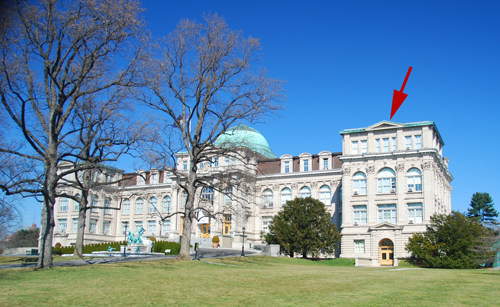
Photo by Wayt ThomasRed-tailed hawk pairs are monogamous, with females (2–4.5 lbs.) larger than males (1.5–3 lbs). The adults have a dark brown back with a pale underbelly and a darker band across the belly; the tail is brick-red above and pinkish below. Our pair is unusual in that they are accompanied by a third hawk—rarely, a second female may help tend the nest and feed the young. This immature bird is an offspring of the pair’s from last year. If everything proceeds according to what we know about these hawks, 1 to 3 eggs will be laid in late March or April—we’ll keep you posted.
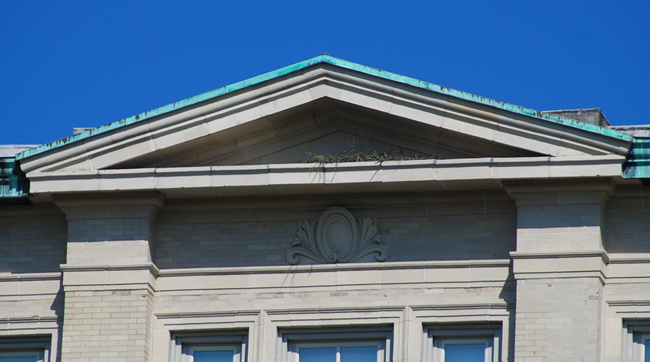
Photo by Wayt ThomasRed-tailed hawks usually feed on small mammals or birds and their preferred habitat is a mix of forest and open areas, such as we have here on the Garden grounds. Their diet consists primarily of squirrels, pigeons, small birds, and rabbits. We don’t know if they are part of the Garden’s Integrated Pest Management plan, but there are fewer squirrels than usual in front of the Library building.
Posted in NYBG in the News, Wildlife on August 19 2008, by Plant Talk
 |
Nick Leshi is Associate Director of Public Relations and Electronic Media. |
 In the September 2008 issue of Outside, a health, fitness, and travel magazine, Eric Hansen wrote a two-and-a-half page feature chronicling his quest to find the Bronx’s elusive José the Beaver. Named as a tribute to Congressman José Serrano, the beaver has garnered an urban legend mystique with sightings along the Bronx River. The writer visited The New York Botanical Garden while researching his story and dubbed our institution “a biologically diverse oasis.”
In the September 2008 issue of Outside, a health, fitness, and travel magazine, Eric Hansen wrote a two-and-a-half page feature chronicling his quest to find the Bronx’s elusive José the Beaver. Named as a tribute to Congressman José Serrano, the beaver has garnered an urban legend mystique with sightings along the Bronx River. The writer visited The New York Botanical Garden while researching his story and dubbed our institution “a biologically diverse oasis.”
Reading this article made me think of all the other amazing wildlife one can see here on a given day. Yes, the Botanical Garden prides itself as a museum of plants with extensive flora in its 50 gardens and plant collections. But visitors might be surprised at the diversity of fauna they could also stumble upon during a visit here. Our neighbor across Fordham Road may have lions and tigers and bears, but a stroll through NYBG reveals an unexpected variety of life from the animal kingdom.
Birds are abundant, from majestic hawks circling overhead to families of ducks ambling along a path. On the Garden’s popular guided Bird Walks, held Saturday mornings September through June, people seek out robins, blue jays, cardinals, sparrows, and even owls. I’ve been amazed to see wild turkeys, blue herons, plump pheasants, and even what looked like an ibis swooping to grab a koi from one of the pools in the Enid A. Haupt Conservatory Courtyards.
If you look closely enough, birds aren’t the only wildlife you’ll see. Chipmunks scurry in the Forest. Frogs belch their songs in the ponds of the Rock Garden, while Italian wall lizards dash across nearby stones. From rabbits and turtles to muskrats and squirrels, it’s incredible to realize how many species of life call our 250 acres “home.”
View our Flickr set of some of our animal friends and more!
 The New York Botanical Garden is, first and foremost, a world-renowned collection of flora. But you’d be hard-pressed to spend more than a few minutes walking under the boughs without recognizing the sing-song notes of our most gregarious residents. The birds of the Garden represent some of the most varied fauna in New York City, and not only are we a haven for passersby making the trip to cozier climates, but we’re further home to a menagerie of year-round species in all shapes and sizes.
The New York Botanical Garden is, first and foremost, a world-renowned collection of flora. But you’d be hard-pressed to spend more than a few minutes walking under the boughs without recognizing the sing-song notes of our most gregarious residents. The birds of the Garden represent some of the most varied fauna in New York City, and not only are we a haven for passersby making the trip to cozier climates, but we’re further home to a menagerie of year-round species in all shapes and sizes.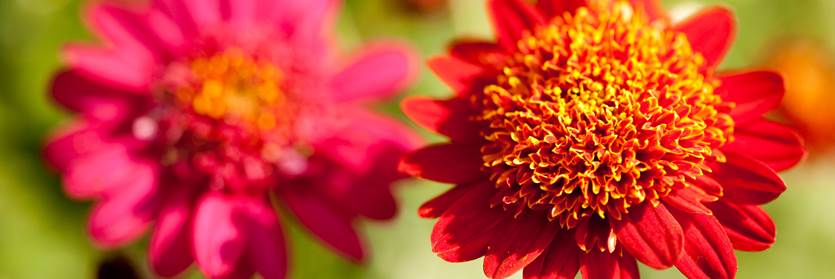

 Start in the historic Enid A. Haupt Conservatory, where the best-smelling exhibition in New York City–complete with flowing fountains and elegant arches–is housed in the Victorian elegance of this landmark building. Be sure to visit the beautiful reflecting pool and its resident koi in the Conservatory Courtyard. A Garden Tour Guide-led guided tour of the exhibition is available Saturday and Sunday at 2:30 p.m. Meet at the entrance to the Conservatory.
Start in the historic Enid A. Haupt Conservatory, where the best-smelling exhibition in New York City–complete with flowing fountains and elegant arches–is housed in the Victorian elegance of this landmark building. Be sure to visit the beautiful reflecting pool and its resident koi in the Conservatory Courtyard. A Garden Tour Guide-led guided tour of the exhibition is available Saturday and Sunday at 2:30 p.m. Meet at the entrance to the Conservatory.
 The Garden is a great place to get outside and enjoy nature: families can explore the natural world in the Everett Children’s Adventure Garden and at the Ruth Rea Howell Family Garden; gardeners can gather inspiration for their own gardens throughout the Garden’s 250-acres, and learn about plant varietals in the Home Gardening Center; and naturalists can spot a variety of migratory and year-round birds throughout the grounds.
The Garden is a great place to get outside and enjoy nature: families can explore the natural world in the Everett Children’s Adventure Garden and at the Ruth Rea Howell Family Garden; gardeners can gather inspiration for their own gardens throughout the Garden’s 250-acres, and learn about plant varietals in the Home Gardening Center; and naturalists can spot a variety of migratory and year-round birds throughout the grounds.









